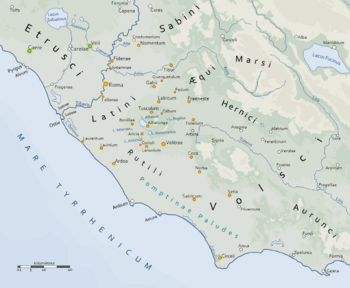Latin League facts for kids
Quick facts for kids
Latin League
Foedus Latinum
|
|||||||||||
|---|---|---|---|---|---|---|---|---|---|---|---|
| 793 BC–338 BC | |||||||||||

Map of the main cities of the Latin League
|
|||||||||||
| Common languages | Latin | ||||||||||
| Government | Tribal Confederation | ||||||||||
| History | |||||||||||
|
• Established
|
793 BC | ||||||||||
|
• Disestablished
|
338 BC | ||||||||||
|
|||||||||||
| Today part of | Italy | ||||||||||
The Latin League was an old group of about 30 villages and tribes. They lived in a region called Latium, close to the famous city of Rome. This group worked together for protection, like a team. They formed a confederation, which means different groups joined together for a common goal. The Latin League existed from around the 8th century BC until 338 BC. Modern historians gave it the name "Latin League."
Contents
Forming the Latin League
The Latin League was first created to protect its members. They needed to defend themselves from enemies living nearby. One of their main threats was the Etruscans, a powerful people who lived north of Latium. The city of Alba Longa was a very important leader in forming this league.
An old writer named Cato the Elder wrote about the league. He mentioned some of the cities that were part of it. These included Tusculum, Aricia, Lanuvium, Lavinium, Cora, Tibur, Pometia, and Ardea.
Rome's Role in the League
Over time, the city of Rome grew stronger. During the rule of Tarquinius Superbus, the last king of Rome, the Latins agreed to let Rome lead them. They renewed a special agreement, or treaty, with Rome. This treaty said that Latin soldiers would join Roman soldiers on a set day. Together, they would form one big army. Tarquin then combined these Roman and Latin troops into united fighting groups.
The Foedus Cassianum Treaty
Later, in 493 BC, the early Roman Republic made an alliance with the Latin League. Roman stories say this treaty, called the Foedus Cassianum, happened after Rome won a battle against the league. This battle was fought at Lake Regillus.
The treaty had important rules. Both Rome and the Latin League would share any treasures or land they won from wars. This sharing of loot later became a reason for the Latin War (341–338 BC). The treaty also stated that Roman generals would lead any military campaigns involving both groups. This alliance helped them fight off attacks from other tribes. These tribes, like the Aequi and the Volsci, lived in the Apennine Mountains. By combining their armies, Rome and the Latin League stopped these tribes from invading Latium.
Historians are still not completely sure about one thing. It's unclear if the Latins accepted Rome as a member of their league. Or, if the treaty was signed as an agreement between Rome and the Latin League as two separate powers.
Wars and the End of the League
Throughout the time of the Roman Kingdom and the early Roman Republic, Rome and the Latins often had disagreements. These disputes led to many wars. Sometimes Rome fought individual Latin cities. Other times, Rome fought against the entire Latin League.
Rome's Growing Power
Rome's power kept growing steadily. This led to Rome slowly taking control of the Latin League. In 358 BC, the original treaty was renewed again. This new agreement officially made Rome the leader of the league. This change eventually caused the Latin War (343–338 BC) to break out.
After Rome won this war, the Latin League was officially ended. This happened in 338 BC.
New Roman Rule
After 338 BC, Rome changed how the former Latin League cities were governed. Rome renamed many of these cities municipia. This meant the towns were now ruled directly by Rome or the Roman Republic. Rome also set up coloniae (colonies) inside these cities. The people living there were then considered Roman colonists.
Main Cities of the League
Here are some of the important cities that were part of the Latin League:
- Alba Longa (This city was a founder but was destroyed in the mid-7th century BC)
- Ardea
- Aricia
- Cameria (Destroyed in 502 BC)
- Cora
- Lanuvium
- Lavinium
- Pometia
- Tibur
- Tusculum

